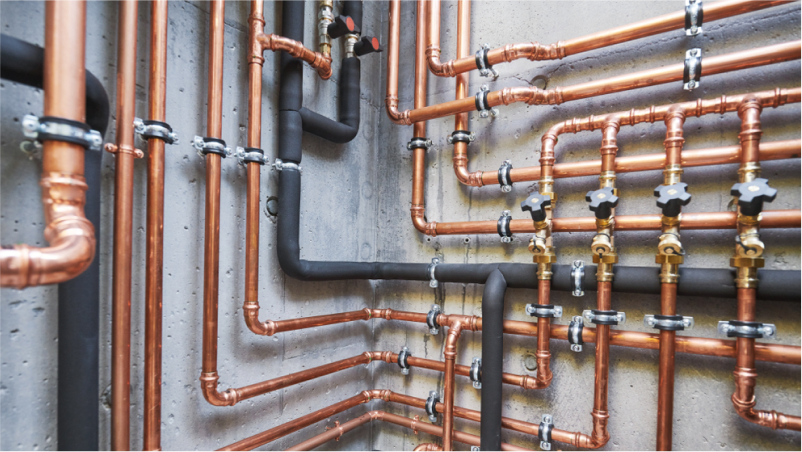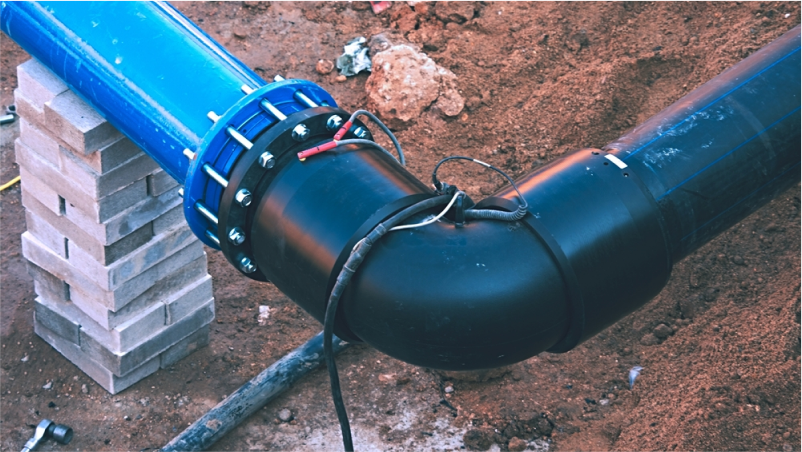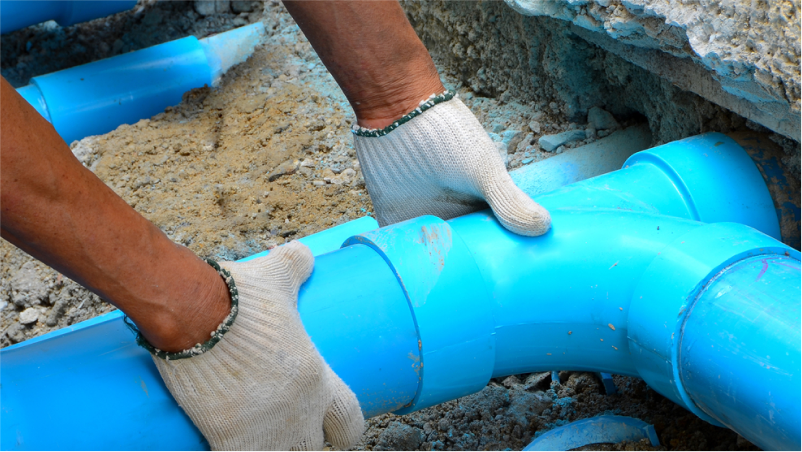Plumbing is the system of pipes, tanks, fittings, connectors, reducers, and other fixtures used to deliver water and remove waste that is water-borne. The fundamental laws of gravity and pressure are followed by the plumbing system.

Plumbing system is one of the most important systems in residential or commercial buildings. It comprises three different types of plumbing systems, mostly for sewage, water, and drainage. Professional plumbers design, build, maintain, and repair each type of plumbing system to ensure efficiency.
In today’s article, we will cover the different types of plumbing systems in depth. You can discover several plumbing system kinds, pipe types, and factors guidelines at the conclusion of this article.
So let’s get started!
Types of Plumbing System
There are three types of plumbing systems: potable, sanitary, and drainage. Each of these plumbing systems is important. Each system has a specific purpose. These systems’ combined efforts eventually give water to a structure and remove water and waste from the structure. All of these systems work together to ultimately supply water to a building and remove waste from it.
Portable Plumbing System
A potable water system delivers water from nearby water mains into buildings. There is a water valve on the water main which allows the water to be turned off if required. There is also a water metre installed to keep track of how much water is utilised in the building.

The potable plumbing system delivers water that can be used for drinking, cleaning, and other human uses. Moreover, to make sure that there are no cross-piping connections with wastewater or unsafe plumbing sources, this water supply line must undergo adequate inspections and maintenance from a qualified plumber. This will ultimately minimise wastage and leakage.
The plumbing system must be able to deal with back pressure or backsiphonage risks. The supply line should not be situated close to any other plumbing systems that could potentially convey contamination. The plumbing products on this line must adhere to the performance and quality standards established by the government or an authorised management board.
What’s more, there are many different types of pipes and fittings in the particular building that are utilised to deliver water to each appliance. They consist of:
Straight Pipes: The potable plumbing system often utilities these pipelines. Straight pipes can be very long or short, however they effectively transport water to their designated area.
T-section: The set up of these piping systems is right-angled.
Elbows: These Elbows are employed in the plumbing system to make directional modifications.
Gate Valves and Brass: The primary function of these appliances is to regulate water flow.
Sanitary Plumbing System
Sanitary plumbing system is responsible for removing all wastage from the building. This waste comprises wastewater and human wastage water such as washing, cleaning and cooking water.

Most of this water is released into the Caloosahatchee River, some of which is reclaimed after treatment to potable water standards and re-flowed into the community. This is a common technique designated to conserve water.
To operate this system at atmospheric pressures, they are connected on the ceiling to evacuate gases. There are 3 different sanitary plumbing system types that can be installed.
Gravity System
This system is the most common and popular type of sanitary system. They efficiently gather the wastewater and transport it to the sewage network by utilising the natural slope of the ground. Moreover, these are mostly utilised in areas with infrequent flooding and low water levels.
Low-Pressure System
This system is a low-head pressure system that can be used instead of a gravity system. Inside the system is an interceptor tank with a chamber unit that holds a small electrical pump. The waste is conveyed to the main sewage plant via small pressure lines installed underground.
Vacuum System
This system uses electricity and is mostly implemented in particular places. This is another option for gravity systems. They consist of flat areas, recovered areas, charged areas, and seasonal places.
Vacuum valves are used to connect the sewage fittings to a central vacuum station. The central vacuum station also includes controls, a collection chamber, discharge pumps, and vacuum pumps.
Drainage Plumbing System
Drainage system is an important part of every building design. The drainage system’s main goal is to regularly remove these extra liquids from the surface to keep the building in good condition.

It includes all of the piping connection types that transports rainfall and other surplus liquids to the disposal point. Its design aims to dispose of water as rapidly as possible to prevent excess water from entering homes or businesses.
Rainwater will soon accumulate if a proper drainage system is not in place. Hence, an effective drainage system is crucial which helps to prevent excess water from damming in your surroundings or on underground surfaces that could harm your property.
Drainage plumbing system aids in the removal of water from roadways, rooftops, walkways, and subterranean spaces to prevent floods. It is critical in residential areas to prevent structural damage, mildew, mould, and rotting caused by flooding.
Drainage systems need to be regularly inspected and maintained by a professional plumber to make sure they are functioning properly. Because, when it rains heavily, improper drainage system maintenance can result in serious issues and property damage.
There are many types of drain pipes systems exist for moving the water, and after that it is transported to the next location, including:
Gravity-Fed System
The drainage systems’ pipes are angled so that water can flow through them directly. The amount/intensity of rainfall and the area’s size are used to calculate the size of the pipes.
Pump-based Method
If the land’s slope precludes the use of gravity-fed systems, pumps might be required. They frequently have tanks for rainfall in addition to pumps for moving the water.
Release and Collection of Stormwater
To move water to nearby rivers, lakes, and the ocean, larger types of piping material and canals might be created.
Now, you must be familiar with the plumbing system by this point. Let’s now discuss the categories within the plumb system. The plumbing system is composed of four different types of classifications.
- Single Stack System
- Partially Vented Single Stack System
- One Pipe System
- Two-pipe System
Its high-capacity pump lift can move trash or wastewater even when they are going against a gravity drain.
This system transports wastewater from washbasins, water closets, and sinks and is connected to a single pipe solely.
The vent pipe in this plumbing system is connected via flange to all of the traps through a single stack.
Separate pipes are used in this two-pipe system plumbing to link the restrooms and discharge washbasins, bathroom fittings, and other fixtures.
Factors to Consider When Choosing a Plumbing System
We have learned about the plumbing system and their types of plumbing system in detail up to this point. We should be aware of the factors to consider while choosing plumbing fixtures. The following are some crucial factors to think about when looking for plumbing fixtures for your upcoming project.
Location
The location of the plumbing system will determine the fixtures you want to buy. When utilising them outdoors, you should use strong, durable fixtures which are made of materials that can withstand the environment and prevent corrosion.
Budget
Always choose top-notch quality plumbing fittings over inexpensive ones. Because a failure brought on by poor materials could end up costing considerably more in the long run than any early savings. Look for inexpensive, best-quality fixtures if money is short. Good quality indications include their warranty and whether they are certified.
Water Quality
The life of your plumbing system may be shortened by the water in your pipes. If it’s corrosive, your pipes will deteriorate in a short amount of period. Moreover, it may dissolve copper and lead into your water supply, causing health issues. Thus, you must have your water tested by a professional if you have any doubt of contamination.
Local Regulations
Regulations provide manufacturers with the minimal acceptable product specifications needed to guarantee consistency in performance, quality, and safety. Regulations provide buyers with assurance as well as informing manufacturers about what is expected of their products.
Maintenance Requirements
To avoid any plumbing related problems, it is critical to recognise that the plumbing system requires correct management as well as frequent inspection and repair from experienced plumbers.
Plumbing systems need to be regularly inspected and maintained by a qualified plumber to make sure they are functioning properly.
The plumbing system is critical to our daily life. The effective operation of the building’s plumbing system depends heavily on the expert plumber.
All plumbing systems, whether residential or commercial, need periodic maintenance and repairs to their parts in order to avoid significant clogs, fixture damage, and to keep all plumbing systems operating properly every day.
